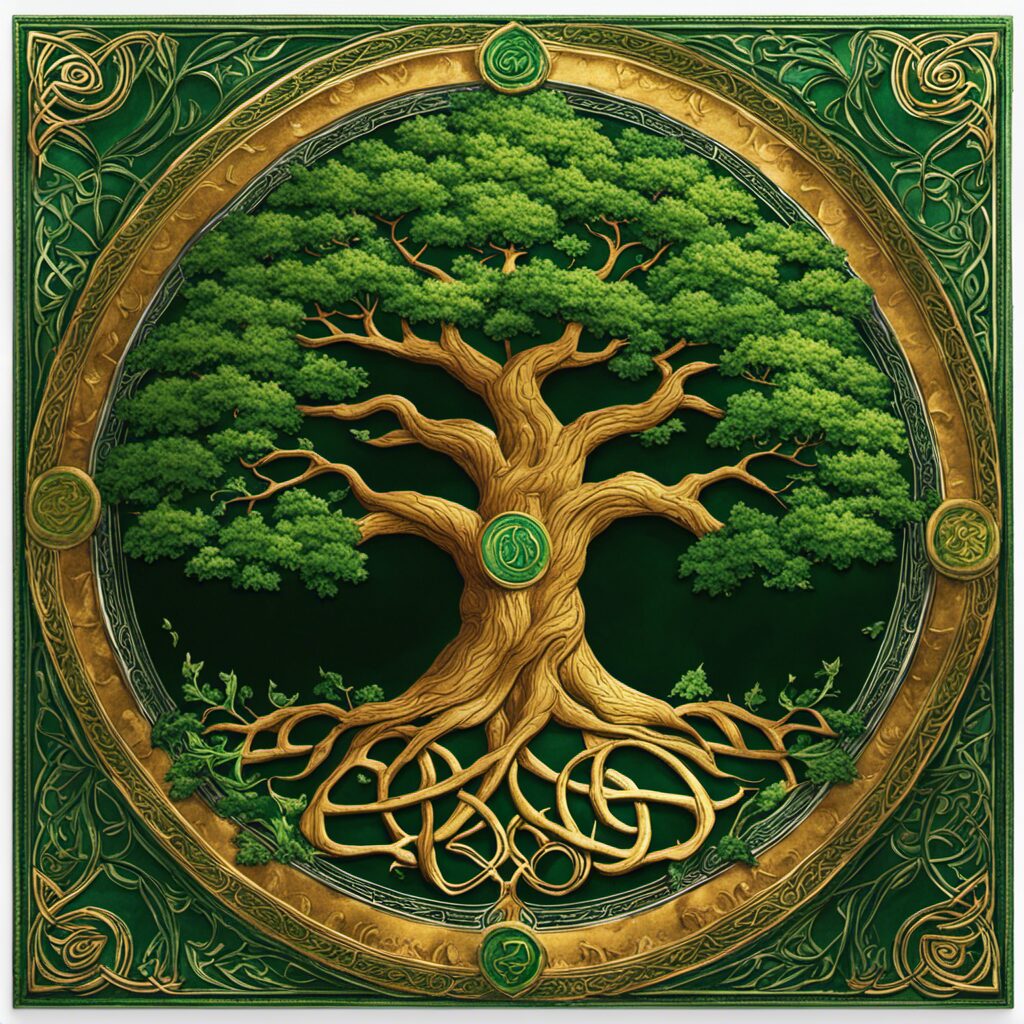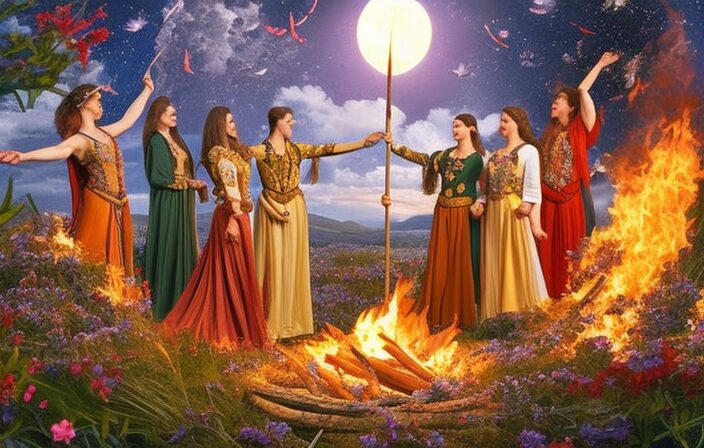The Celtic calendar, with its intricate system of festivals and celebrations, provides a lens through which we can examine the role of gender in ancient Celtic society.
By exploring the influence of this calendar on gender roles in mythology, folklore, and contemporary society, we gain insights into the legacy it has left behind.
This article aims to analyze the origins of the Celtic calendar, investigate its impact on defining gender roles, and evaluate its relevance in shaping modern perceptions of gender equality.
Key Takeaways
- The Celtic calendar was based on lunar cycles and incorporated elements from solar observations, marking important agricultural and astronomical events.
- Gender dynamics in Celtic society were characterized by balance and collaboration, with active participation of both men and women in rituals and celebrations.
- Celtic society had flexibility and fluidity in gender roles, with equal opportunities for men and women in various activities and no strict division of labor or hierarchy between genders.
- Gender roles in Celtic festivities reflected societal values, with men organizing and leading public rituals while women were involved in food preparation and maintaining traditions.
The Origins of the Celtic Calendar


The origins of the Celtic calendar can be traced back to ancient Celtic societies, where it played a significant role in marking important agricultural and astronomical events. The development of this calendar was closely tied to the agricultural practices and natural phenomena observed by the Celts. It was primarily based on lunar cycles, with each month corresponding to a specific phase of the moon. The Celts believed that these lunar phases influenced various aspects of their lives, including planting, harvesting, and hunting.
Additionally, the Celtic calendar also incorporated elements from solar observations. This is evident in the celebration of solstices and equinoxes which marked important points in the yearly cycle. These celestial events were seen as crucial times for religious rituals and festivities.
The cultural significance of the Celtic calendar extended beyond its practical use for agricultural purposes. It served as a tool for organizing social activities and religious ceremonies within Celtic communities. The timing of festivals and gatherings was often determined by this calendar, allowing communities to come together to celebrate shared traditions and beliefs.
The Role of Gender in Ancient Celtic Society
This discussion will explore the role of gender in ancient Celtic society. Specifically, it will focus on the concepts of equality, gender roles, and gender dynamics.
It is important to examine these aspects in order to gain a comprehensive understanding of how gender functioned within this society. By analyzing historical evidence and scholarly research, we can shed light on the complexities and nuances of gender relations in Celtic culture.
Equality in Celtic Society
Equality in Celtic society was a fundamental principle that governed the roles and responsibilities of individuals, regardless of their gender. This principle extended to various aspects of life, including rituals and celebrations.
In Celtic rituals, equality was evident as both men and women participated actively. Gender dynamics in Celtic celebrations were characterized by a sense of balance and collaboration. Men and women had equal opportunities to contribute to the festivities, with each gender having specific roles but none being superior or inferior to the other.
For example, women often played important roles in religious ceremonies, acting as priestesses or seers. They also had significant influence in decision-making processes within their communities.
The emphasis on equality in these cultural practices highlights the importance that Celtic society placed on fairness and egalitarianism.
Gender Roles in Celts
Egalitarian principles were prominent in Celtic society, as evidenced by the balanced participation of both men and women in various aspects of cultural practices. In ancient Celtic society, gender roles were not strictly defined or rigidly enforced. Men and women had equal opportunities to engage in activities such as warfare, trade, and religious ceremonies.
While some tasks may have been more commonly associated with one gender than the other, there was flexibility and fluidity in these roles. The influence of the Celtic calendar on gender roles today can be seen in the impact of ancient traditions on modern gender dynamics. The celebration of festivals, such as Beltane and Samhain, continue to provide spaces for individuals to explore alternative expressions of identity and challenge traditional societal expectations regarding gender roles.
Ancient Celtic Gender Dynamics
The ancient Celts exhibited a notable flexibility and fluidity in the roles assigned to individuals based on their gender. Ancient Celtic gender norms were shaped by societal influences, which played a significant role in defining and assigning these roles.
The Celts valued both men and women for their unique contributions to society, and there was no strict division of labor or hierarchy between genders. Women held positions of power and influence, such as warrior queens and priestesses, while men engaged in various occupations including farming, craftsmanship, and warfare.
The societal influence on gender roles can be seen through the presence of goddesses associated with fertility and sovereignty, highlighting the importance given to women’s reproductive capabilities within Celtic society.
Overall, the ancient Celts displayed a more egalitarian approach towards gender roles compared to many other contemporary cultures.
The Festivals and Celebrations in the Celtic Calendar


The influence of gender roles on festivities in ancient Celtic society is a significant aspect worth exploring. These gender roles played a crucial role in shaping the nature and dynamics of various celebrations and rituals within the Celtic calendar.
Additionally, the significance of these celebrations cannot be understated, as they served as important markers for the community, reflecting their values, beliefs, and social structure.
Furthermore, by examining the festivals and traditions observed by the Celts, we can gain valuable insights into their societal values and priorities during that time period.
Gender Roles Influence Festivities
Gender roles within Celtic society had a substantial impact on the nature and organization of festive celebrations. The influence of gender roles on cultural traditions was evident in the way festivities were structured and carried out.
Men and women had distinct roles and expectations during these events, which shaped the overall experience. For instance, men often took charge of organizing and leading public rituals, while women played significant roles in preparing food, creating decorations, and maintaining familial traditions.
These gender expectations influenced not only the division of labor but also the symbolic meaning attached to certain festivities. Women’s involvement in domestic tasks contributed to the nurturing and communal aspects of celebrations, while men’s leadership reflected their societal role as protectors and providers.
Thus, gender roles played a crucial role in shaping the dynamics and practices of festive rituals within Celtic society.
Significance of Celtic Celebrations
The significance of Celtic celebrations lies in their deep connection to the cultural and religious practices of the ancient Celtic people. These festivities played a crucial role in the social fabric of Celtic society, serving as markers for important events such as agricultural cycles, solstices, equinoxes, and other celestial occurrences. The rituals performed during these celebrations were believed to ensure fertility, abundance, protection from evil spirits, and overall well-being.
Furthermore, Celtic celebrations have left a lasting impact on modern society. Many of their traditions and customs have been incorporated into contemporary festivals and holidays observed around the world. For example, Halloween is said to have originated from the ancient Celtic festival of Samhain. Additionally, elements of Celtic music, dance, art, and storytelling continue to influence various forms of artistic expression today.
Overall, the significance of Celtic celebrations extends beyond their historical context; they continue to shape our cultural landscape and connect us to our shared human heritage.
Festivals Reflect Societal Values
Festivals provide a platform for societies to showcase their values and beliefs through various cultural practices and rituals. They serve as social indicators, reflecting the prevailing norms and customs of a community.
Festivals have a significant impact on cultural norms, as they reinforce existing traditions or introduce new ones. Through these celebrations, communities convey messages about their collective identity, religious beliefs, gender roles, social hierarchies, and power dynamics.
Festivals often involve specific roles and responsibilities assigned to individuals based on their gender or social status. These roles may include performing certain rituals or participating in specific activities that symbolize societal expectations.
By engaging in these festivals, individuals not only strengthen cultural bonds but also contribute to the perpetuation of these norms within society.
Thus, festivals play a crucial role in shaping and maintaining cultural values and practices.
Gender Roles in Celtic Mythology and Folklore
Throughout Celtic mythology and folklore, there exists a complex web of societal expectations and roles that are deeply intertwined with the traditional narratives and beliefs.
Gender roles in Celtic mythology often reflect the gender dynamics prevalent in Celtic folklore, highlighting the social norms and values of the society. In many Celtic myths, women are portrayed as strong, independent figures who possess supernatural abilities and play vital roles in shaping the destiny of their communities. However, these representations should not be seen as indicative of an egalitarian society; rather, they reveal a complex interplay between gender ideals and societal expectations.
In Celtic folklore, women were often associated with fertility and nature. They were revered as divine beings who held power over life-giving forces. This connection between femininity and natural abundance is evident in stories featuring goddesses such as Brigid or Danu. These goddesses symbolize feminine attributes like creativity, wisdom, healing, and protection. On the other hand, men were often depicted as warriors or hunters – roles that emphasized their physical strength and bravery.
While these portrayals may suggest a level of gender equality within Celtic mythology and folklore, it is important to recognize that they also reinforce traditional notions of gender roles found in many ancient societies. Women’s power was often tied to their ability to bear children or connect with mystical forces rather than being granted equal status in political or economic realms. Men remained dominant figures in positions of authority while women’s agency was more closely tied to their reproductive capacities.
Overall, gender roles in Celtic mythology provide insight into the societal values surrounding masculinity and femininity during this period. Though some female characters display strength and independence beyond what might be expected from a patriarchal society at first glance, closer analysis reveals that these representations still uphold traditional gender dynamics where male power predominates over female empowerment.
The Influence of the Celtic Calendar on Gender Roles Today


One of the lasting legacies of Celtic tradition is the way in which it shapes contemporary understandings of gender dynamics. The influence of the Celtic calendar on gender roles today can be seen in its impact on modern feminism and the LGBTQ+ community.
The Celtic calendar, with its emphasis on cycles and natural rhythms, provides a framework that challenges traditional binary notions of gender. In terms of modern feminism, the Celtic calendar encourages a more fluid understanding of gender by highlighting the interconnectedness between masculine and feminine energies. This challenges the rigid stereotypes and expectations placed upon individuals based on their assigned sex at birth.
By recognizing and celebrating the diversity of gender expressions within their cultural heritage, many individuals have found inspiration to challenge societal norms and advocate for greater equality. Furthermore, the impact of the Celtic calendar extends to the LGBTQ+ community. Its recognition of multiple genders and non-binary identities aligns with contemporary discussions about gender identity and sexual orientation.
The ancient Celts acknowledged various non-binary roles such as druids who were not confined to traditional male or female roles. This historical acceptance provides validation for those who identify outside traditional gender categories today. Overall, through its influence on modern feminism and its impact on the LGBTQ+ community, the Celtic calendar has contributed to shaping contemporary understandings of gender dynamics by challenging traditional binary frameworks and promoting inclusivity.
Exploring Gender Equality in Celtic Society


In order to understand the gender roles in Celtic society, it is important to explore gender stereotypes and the roles assigned to men and women in ancient rituals. The Celtic calendar provides valuable insight into these aspects of their culture.
Gender stereotypes were prevalent in Celtic society, with distinct expectations for men and women. Men were often associated with strength, bravery, and leadership, while women were seen as nurturing, domesticated, and responsible for maintaining the household. These stereotypes influenced various aspects of daily life including social interactions, marriage practices, and inheritance laws.
Ancient rituals played a significant role in reinforcing these gender roles. For instance, certain ceremonies were exclusively performed by men or women, highlighting their respective roles within the community. Men participated in public ceremonies that showcased their physical prowess and military skills, while women played integral roles in fertility rites and agricultural rituals.
Overall, exploring gender stereotypes and gender roles in ancient rituals sheds light on how the Celtic calendar shaped societal norms pertaining to masculinity and femininity. Understanding these dynamics allows us to gain a deeper understanding of gender equality or lack thereof in Celtic society during this period.
The Legacy of the Celtic Calendar on Gender Roles in Modern Society


The influence of the Celtic calendar on contemporary gender expectations and stereotypes can be observed in modern society. The legacy of Celtic festivals and the impact of Celtic mythology have contributed to shaping gender roles and perceptions.
In many Celtic festivals, such as Beltane and Samhain, there was a strong emphasis on fertility and the interconnectedness of nature with human life. These celebrations often involved rituals that highlighted the importance of women in procreation and nurturing. Additionally, Celtic mythology portrayed powerful female deities such as Brigid, who represented healing, poetry, and childbirth.
These cultural practices and mythological beliefs have left a lasting impact on contemporary gender norms. While some may argue that these traditions reinforce traditional gender roles by associating women with domesticity and childbirth, others argue that they celebrate femininity and acknowledge its power in various aspects of life.
Nonetheless, it is important to recognize that societal attitudes towards gender have evolved over time, influenced by numerous factors beyond just the Celtic calendar.
Overall, the legacy of Celtic festivals and the impact of Celtic mythology continue to shape contemporary gender expectations in modern society. By understanding these historical influences, we can better comprehend how past traditions contribute to current understandings of femininity and masculinity.
Conclusion
Overall, the Celtic calendar played a significant role in shaping gender roles in ancient society. It influenced the festivals and celebrations that were held throughout the year, providing opportunities for both men and women to partake in various activities and rituals.
Additionally, Celtic mythology and folklore further reinforced these gender roles, depicting men as warriors and women as nurturers.
Today, we can still see remnants of these gender roles in modern society. The legacy of the Celtic calendar continues to impact how we perceive gender equality, reminding us of the deep-rooted traditions that have shaped our understanding of societal roles.




